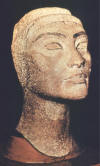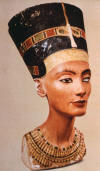Statue of Akhenaton **"A
colossal statue of Akhenaton from Karnak, toppled and buried
after his death, retains the standard frontal pose of
canonical pharonic portraits. But the effeminate body,
with its curving contours, and the long full-lipped face,
heavy lidded eyes, and dreaming expression are a far cry
indeed from the heroically proportioned figures of
Akhenaton's predecessors. Akhenaton's body is
curiously misshapen, with weak arms, a narrow waist,
protruding belly, wide hips, and fatty thighs. Modern
doctors have tried to explain his physique [but] ... their
premise - that the statue is an accurate depiction of a
physical deformity - is probably faulty."
- Gardner's
Art Through The Ages,
11th edition, Vol. I, p. 68 - 69

*************************************************
Bust of Nefertiti **
Though damaged, this bust
still retains an elegant portrayal of queen Nefertiti.
When compared to the painted limestone bust of the queen,
many individually identifiable characteristics become quite
clear. See which identifying features you can see in
both this bust and the painted one.

*************************************************
Painted
Head of Nefertiti **
"The famous painted
limestone bust of Akhenaton's queen, Nefertiti ... was found
in the workshop of the queen's official sculptor, Thutmose.
... [The figure is similar to] those modern descendants of
Nefertiti (her name means "The Beautiful One is Here) -
models in fashion magazines, with their gaunt swaying
frames; masklike faces; and enormous shadowed eyes."
- Gardner's
Art Through The Ages,
11th edition, Vol. I, pp. 69 - 70

**********************************************
Painted Floor
**
Little remains of
Akhenaton's capital of el-Amarna. Aside from some of
the foundations of the buildings and a few commemorative
stelae and fragments in the area, there is little to show
for his city dedicated to the Aton. One of the few
surviving fragments is this floor painting depicting birds
in flight and the vegetation of the Nile Valley.

|